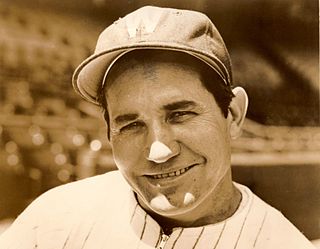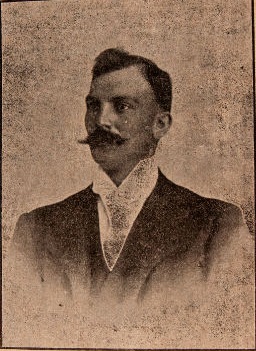Related Research Articles

Adolfo Domingo De Guzmán Luque was a Cuban starting pitcher in Major League Baseball (MLB) from 1914 to 1935. He spent 12 seasons of his career (1918–1929) with the Cincinnati Reds. Luque was not only the first Latin American pitcher in MLB, but also the first to earn a World Series win, and the first to lead the majors in wins, shutouts and earned run average (ERA).

Miguel Ángel González Cordero was a Cuban catcher, coach and interim manager in Major League Baseball (MLB) during the first half of the 20th century. Along with Adolfo Luque, González was one of the first Cubans or Latin Americans to have a long career in the American major leagues.
The Cuban League was one of the earliest and longest lasting professional baseball leagues outside the United States, operating in Cuba from 1878 to 1961. The schedule usually operated during the winter months, so the league was sometimes known as the "Cuban Winter League."

The Habana B.B.C. also known as the Habana Reds or, later, the Leones del Habana was one of the oldest and most distinguished baseball teams in the old Cuban League, which existed from 1878 to 1961. Habana, representing the city of Havana, was the only team to play in the league every season of its existence and was one of its most successful franchises. In their early history they were known by their colors as the Reds; later they adopted the names of Leones or Lions. Throughout their existence they had a famous rivalry with Almendares.

Conrado Eugenio Marrero Ramos, nicknamed "Connie", was a Cuban professional baseball pitcher. The right-handed Marrero pitched in Major League Baseball from 1950 to 1954 for the Washington Senators.
The Cuban Baseball Hall of Fame is a hall of fame that honors eminent baseball players from Cuban baseball. Established in 1939 to honor players, managers, and umpires in the pre-revolution Cuban League, by 1961 it had honored 68 players, managers, and umpires whose names are shown on a marble plaque at Havana's Estadio Latinoamericano. After the revolution, however, the Hall of Fame languished for more than 50 years, seldom mentioned or acknowledged and with no new inductees. Following a campaign led by Cuban filmmaker Ian Padrón, a meeting was held on November 7–8, 2014 to reformulate the Hall of Fame and to propose a museum in which it would be housed. The reformulated Hall recognized the original 68 members, and a jury of 25 people selected 10 new inductees—five from the pre-revolution period and five representing for the first time the post-revolution Cuban National Series. The planned site for the new museum is in the José Antonio Echeverría Workers' Social Club.

José Rodríguez, nicknamed "Joseíto" or "El Hombre Goma" in Spanish and "Joe" in English, was a Cuban infielder who played in Major League Baseball from 1916 to 1918 and in the Cuban League from 1914 to 1939. In the majors, he played for the New York Giants and was primarily a second baseman, while in the Cuban League and the U.S. minor leagues he mostly played first base. A defensive specialist, according to Roberto González Echevarría, Rodríguez "was considered the best defensive first baseman in Cuba" of his time. He was also a long-time manager in the Cuban League and managed for one season in the minors. He was inducted into the Cuban Baseball Hall of Fame in 1951.
The American Series was the name given to the exhibition baseball games played between Cuban and American teams in Cuba. Before the Cuban Revolution, American teams would regularly travel to Cuba and play various professional, all-star and/or amateur Cuban teams throughout the country. The series usually took place either in the fall, after the end of the American season, or during spring training before the season began. The first American Series took place in 1879, with then minor league Worcester team going 2–0 against its Cuban opponents.

Pedro Dibut Villafana was a Major League Baseball pitcher who played for the Cincinnati Reds in 1924 and 1925. In 1923 Dibut played for the Cuban Stars (West) in the Negro National League, one of several white Cubans who played in both Negro league baseball and in the then-segregated major leagues.
The Leopardos de Santa Clara were a Cuban professional baseball team based in Santa Clara, Cuba. Founded in 1922, they played in the Cuban League from 1922 to 1925, from 1929 to 1930, and from 1935 to 1941. Although they competed for only 11 seasons, they won league championships in four regular seasons and in one "special season." According to Cuban League historian Jorge S. Figueredo, the 1923/24 team, which went 36–11 and won the championship by 11+1⁄2 games, is "considered as the most dominant team in the history of Cuban baseball."
Club Fé was a Cuban baseball team based in Havana in the Cuban League. It played in 1882, 1885, from 1887 to 1890, and again from 1901 to 1914.

Antonio María García Callaghan, nicknamed "El Inglés", was a Cuban baseball catcher in the Cuban League. He played from 1882 to 1905 with several Cuban ballclubs, including Almendares, the Fe club, Habana, and the All Cubans. He was elected to the Cuban Baseball Hall of Fame in 1939.

Moisés Quintero Cavada was a Cuban baseball catcher in the Cuban League and Negro leagues. He played from 1887 to 1904 with Habana, Progreso, Almendares, the All Cubans, and Club Fé. He was elected to the Cuban Baseball Hall of Fame in 1953.
The Long Branch Cubans were a professional baseball team that played from 1913 to 1916. It was the first U.S. minor league baseball team composed almost entirely of Cubans. Several players, including Dolf Luque and Mike González, went on to play in the major leagues. The Cubans played in Long Branch, New Jersey from 1913 to 1915, except for the first half of the 1914 season, when they played in Newark, New Jersey. In 1916, they started the season playing in Jersey City, New Jersey as the "Jersey City Cubans." Later that summer, they moved their home games to Poughkeepsie, New York, where they were usually referred to as the "Long Branch Cubans." In late July 1916 they briefly moved to Harlem and finally to Madison, New Jersey in August.

Alfredo Arcaño was a Cuban baseball left fielder in the Cuban League. He played from 1888 to 1909 with several ballclubs, mostly with the Habana club. He was elected to the Cuban Baseball Hall of Fame in 1940.

Miguel Prats was a Cuban baseball rightfielder in the Cuban League and Negro leagues. He played from 1888 to 1908 with several teams, including Progreso, Almendares, Azul, Club Fé, All Cubans, Cuban Stars (West), Habana, and Matanzas.
San Francisco was a Cuban baseball team based in Havana. They played in the Cuban League in the 1900, 1901, and 1903 seasons, while playing in the Cuban Special Championship in 1899, and the Cuban Summer Championship in 1907.
The Orientals were a Cuban baseball team in the Cuban League based in Havana. They played during the winter of 1916-1917 and Armando Marsans served as manager.
Matanzas was a Cuban baseball team in the Cuban League based in Matanzas. They first played in the league's inaugural season of 1878, then played in the league from 1888 to 1890, 1892–1894, and in 1907–1908.
Alfredo Arango was a Cuban baseball player in the Cuban League who played with Almendares from 1885 to 1887 and Habana in 1890–1891.
References
- Figueredo, Jorge S. (2003), Cuban Baseball: A Statistical History, 1878–1961, Jefferson, North Carolina: McFarland & Company, ISBN 078641250X